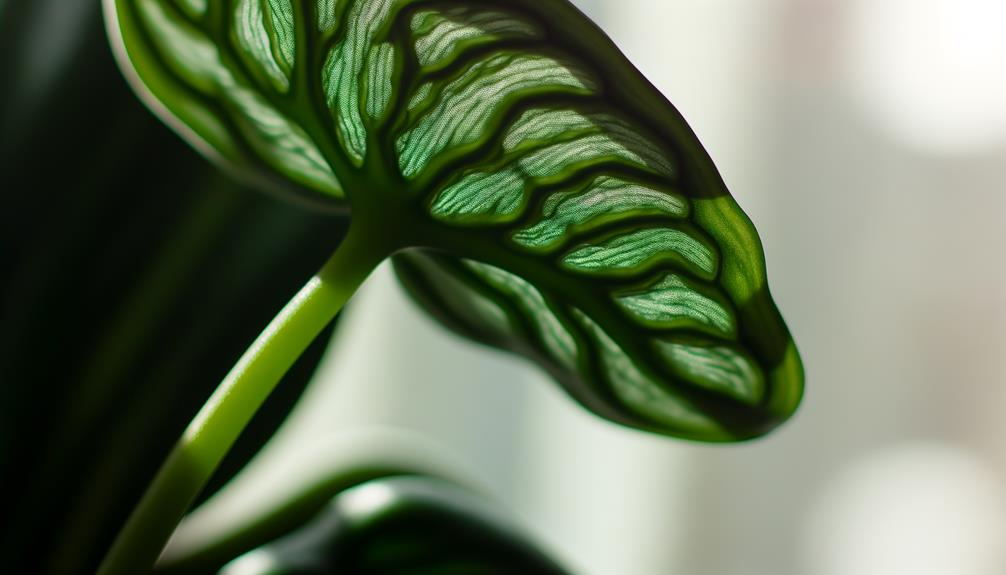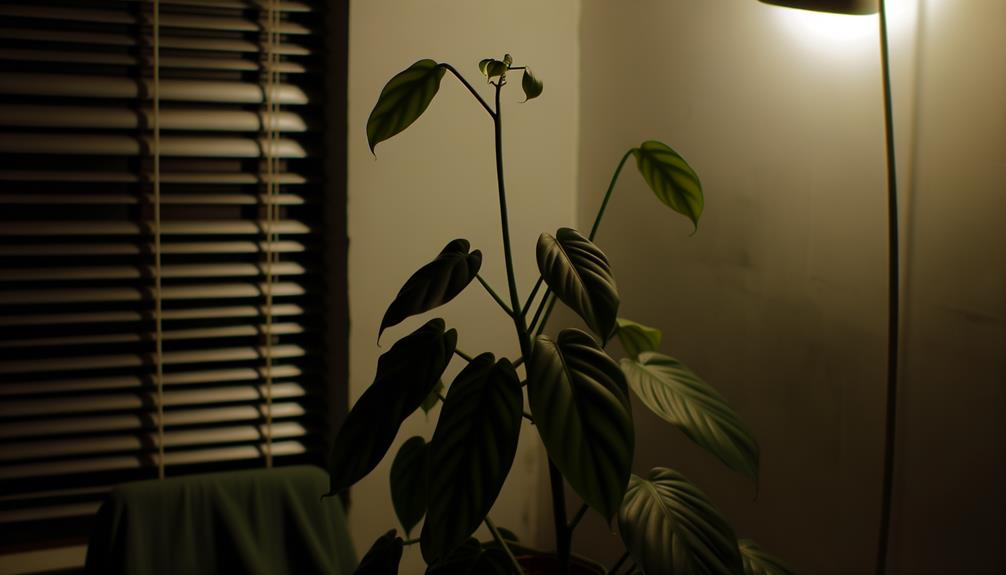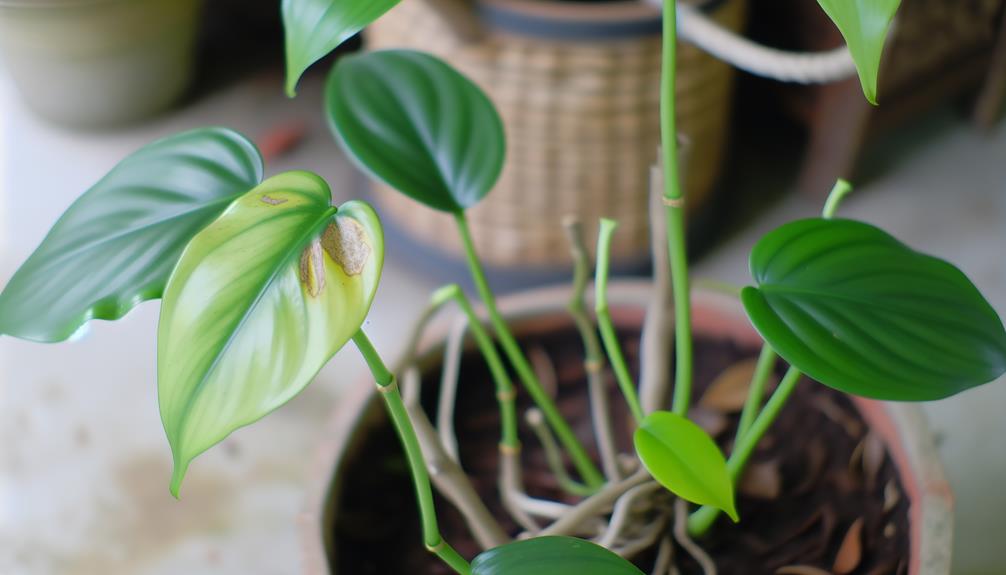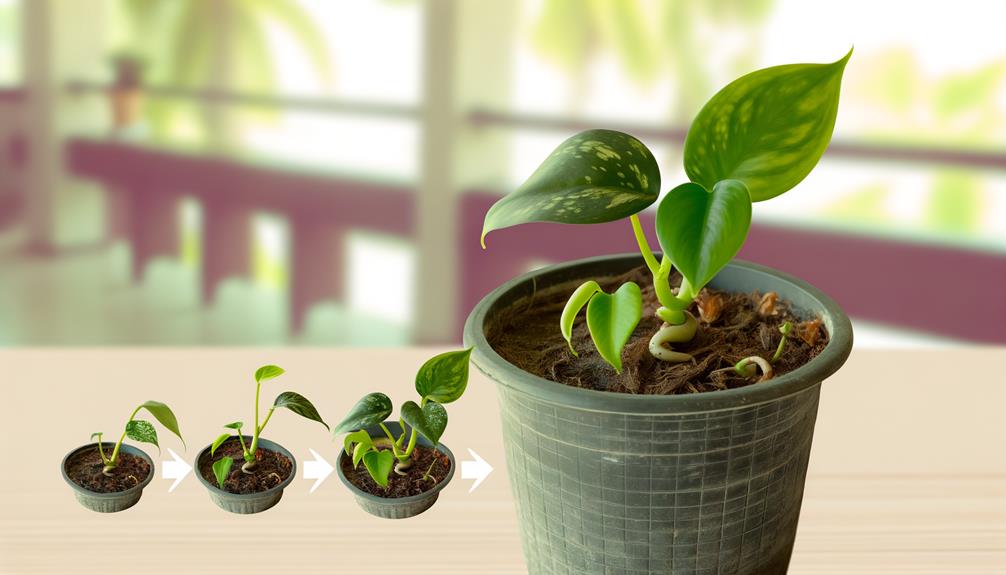Why Does My Philodendron Micans Have Small Leaves?
The small leaves on your Philodendron micans are likely due to subpar conditions disrupting its growth. Insufficient lighting hampers photosynthesis, essential for leaf expansion (Taiz & Zeiger, 2015).
Improper watering, causing root hypoxia or water stress, affects metabolic activities (Lambers et al., 2008). Nutrient deficiencies, particularly in nitrogen, phosphorus, and potassium, impair chlorophyll synthesis and cellular growth (Marschner, 2012).
Temperature stress, outside the ideal 65-80°F range, disrupts enzymatic functions and nutrient transport (Smith, 2002). Lastly, inadequate pot size or soil composition constrains root aeration and nutrient uptake (Brady & Weil, 2010).
Enhance plant health with these detailed insights.

Key Takeaways
- Insufficient light exposure leads to smaller leaves due to reduced photosynthesis and chlorophyll content.
- Overwatering or underwatering disrupts metabolic activities, causing small leaf growth.
- Nutrient deficiencies, particularly in nitrogen, phosphorus, and potassium, hinder leaf expansion and overall growth.
- Temperature stress outside the range of 65-80°F affects enzymatic activities and nutrient transport, leading to smaller leaves.
- Improper pot size or soil composition restricts root growth and nutrient uptake, causing reduced leaf size.
Inadequate Lighting

Insufficient light exposure is a primary factor contributing to the reduced leaf size observed in Philodendron micans, impeding the plant's ability to photosynthesize effectively.
Light is a critical component in the photosynthetic process, which drives the synthesis of glucose, essential for growth and cellular function (Taiz & Zeiger, 2010).
Philodendron micans, being a tropical understory plant, thrives best in bright, indirect light. However, subpar lighting conditions, particularly in indoor environments, lead to etiolation—where the plant prioritizes stem elongation over leaf development (Smith, 1982).
Consequently, the chlorophyll content and overall leaf surface area decrease, reducing the plant's photosynthetic efficiency.
Ensuring adequate light intensity, ideally 2000-2500 lux, is crucial for maintaining the morphological integrity and health of Philodendron micans.
Improper Watering
Improper watering practices greatly affect the leaf size of Philodendron micans. Both overwatering and underwatering can disrupt the plant's physiological processes and nutrient uptake (Jones & Jones, 2001).
Overwatering leads to root hypoxia, reducing oxygen availability and causing root rot. This impairs water and nutrient absorption. On the other hand, underwatering induces water stress, triggering stomatal closure to minimize water loss. Subsequently, this reduces photosynthetic efficiency (Taiz & Zeiger, 2010).
Both conditions result in the production of smaller leaves due to compromised cellular expansion and hindered metabolic activities. Consistent and appropriate watering schedules, tailored to the plant's environmental conditions and growth stage, are imperative for maintaining ideal leaf size.
Monitoring soil moisture levels can prevent these detrimental effects and promote healthy growth.
Nutrient Deficiencies

Nutrient deficiencies have a profound impact on the leaf size of Philodendron micans by disrupting essential metabolic pathways necessary for cellular growth and development (Epstein & Bloom, 2005).
Nitrogen, phosphorus, and potassium are critical macronutrients that influence photosynthesis and ATP synthesis, essential for leaf expansion (Marschner, 2012).
A deficiency in nitrogen can hinder chlorophyll production, resulting in chlorosis and stunted leaf growth (Hawkesford et al., 2012).
Phosphorus is pivotal for energy transfer and root development, and its scarcity can impede cellular division and elongation (Raghothama, 1999).
Potassium deficiencies lead to poor water regulation and reduced enzyme activation, further constraining leaf size (Leigh & Wyn Jones, 1984).
Addressing these deficiencies through balanced fertilization can enhance leaf development.
Temperature Stress
Temperature stress significantly influences the growth and leaf size of Philodendron micans by disrupting cellular homeostasis and enzymatic activities (Taiz & Zeiger, 2010).
Best growth temperatures for Philodendron micans range between 65-80°F (18-27°C). Deviations from this range can impair metabolic processes, such as photosynthesis and respiration, leading to stunted growth and reduced leaf size (Salisbury & Ross, 1992).
During cold stress, membrane fluidity decreases, affecting nutrient transport and cytokinin synthesis, which are essential for cell division and expansion (Huner et al., 1998).
Conversely, high temperatures can cause protein denaturation and increased transpiration rates, resulting in cellular dehydration and oxidative stress (Larkindale & Knight, 2002).
Maintaining a stable temperature is vital for the healthy development of Philodendron micans.
Pot and Soil Issues

The growth and leaf size of Philodendron micans can be greatly affected by the choice of pot and soil composition, as these factors influence root aeration, moisture retention, and nutrient availability (Raven, Evert, & Eichhorn, 2005).
Improperly sized pots can lead to root-bound conditions, impeding nutrient uptake and stunting leaf development. Additionally, a well-draining soil mix, rich in organic matter, is essential for best growth. Soil that retains too much water can cause root rot, while overly sandy soils may lead to nutrient deficiencies.
Using a balanced potting medium, such as a blend of peat, perlite, and orchid bark, can enhance aeration and drainage, thereby promoting healthier, larger leaves (Taiz & Zeiger, 2010).
Conclusion
To sum up, the small leaf size of Philodendron micans can be linked to various key factors. These include inadequate lighting, incorrect watering methods, lack of nutrients, temperature challenges, and less-than-ideal potting conditions.
Tackling these issues accurately will help the plant flourish. Neglecting them, though, poses a threat of diminishing this plant's extraordinary beauty, robbing it of its lush magnificence.
Correct horticultural practices are essential for the best growth and well-being of Philodendron micans.






